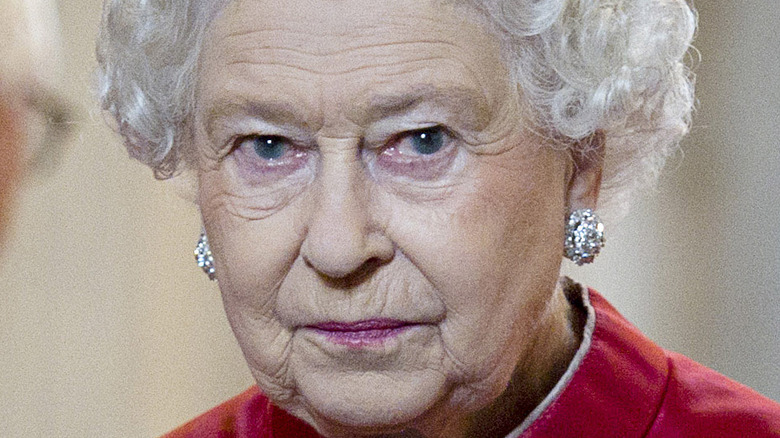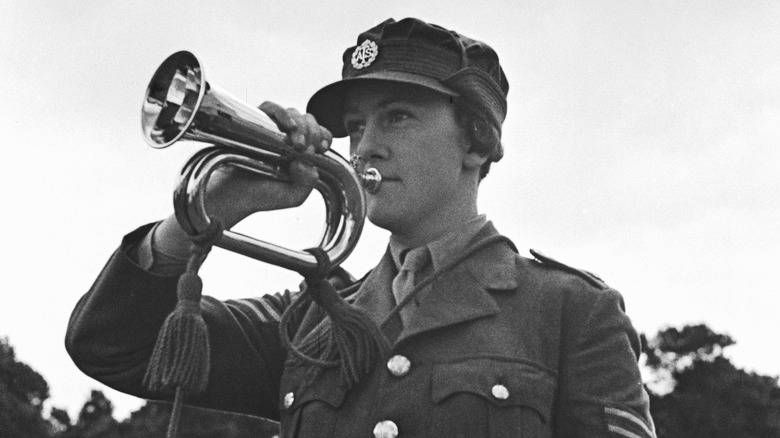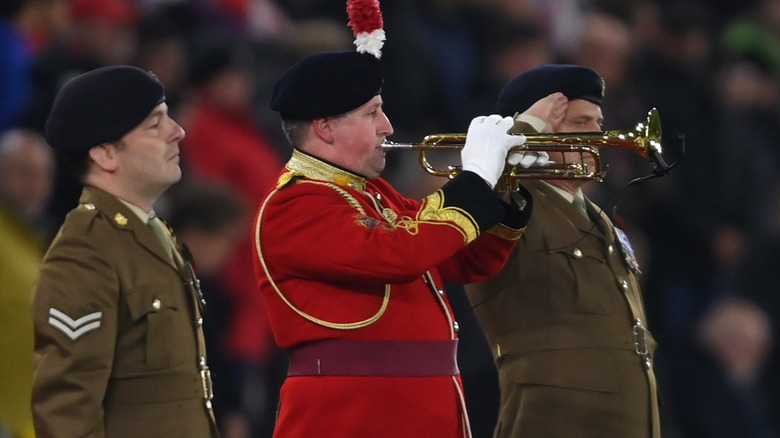The Storied History Of The 'Last Post' That Will Mark The End Of Queen Elizabeth's Funeral
Near the end of the funeral of Queen Elizabeth II, who died at the age of 96 on September 8, a bugler will perform something called the Last Post (via BBC News). The funeral, which will take place Monday, September 19 in London's Westminster Abbey, will begin at 11 a.m. local time. At around 11:55 a.m., the distinct bugle call will sound, signalling two minutes of silence to be observed across the U.K. Then, the funeral will conclude with the national anthem and a lament played by the queen's piper.
But what is the Last Post and why does it have a place in the queen's funeral? The Last Post is an approximately 75-second bugle piece, according to BBC News. It is the rough equivalent in the Commonwealth of Taps in the U.S., as both are associated with the end of the military day and are frequently played at memorial services, according to Taps Bugler. Because it was first played on military instruments like the bugle that do not have any valves, the Last Post developed to consist of only three notes known as the tonic, the mediant, and the fifth, Classic FM explained.
Military origins
The Last Post started more as a timekeeping device for British soldiers of the 17th and 18th centuries than as a mournful song. "At that time soldiers didn't have wristwatches, so they had to be regulated in camp," Museum of Army Music archivist Colin Dean told BBC News. "They had to have a trumpet call or a bugle call to tell them when to get up, when to have their meals, when to fetch the post, when to get on parade, when to go to bed and all other things throughout the day." In all, there were more than 20 of these calls, starting with Reveille and ending with the Last Post.
According to the Taps Bugler, the Last Post most likely developed during the 17th century as part of a longer nighttime ritual. This was the Tattoo, when the officer on duty had to make sure that all sentry positions were filled and all off-duty soldiers were out of the bars and on their way to their quarters. The First Post would sound when the officer began his rounds and the Last Post would sound when he completed them. It was also played whenever a battle concluded, signalling to the wounded that it was safe to seek help, according to Classic FM. By the 1790s, it was published as a piece of music, according to BBC News.
From day's to life's evening
The Last Post's evolution into a funeral melody began in the 1850s, according to BBC News. During this time, military band members began to be primarily civilians in the U.K., which meant they did not follow the armed forces abroad. Therefore, when a soldier did die overseas, the bugle was the only instrument available for the funeral. A tradition therefore emerged of playing the Last Post over the graves of fallen soldiers. The music also changed so that the notes were held for longer, making it more appropriate for funerals, according to Classic FM.
By the outbreak of World War I, the Last Post was already firmly associated with memorials. It was even sometimes played at the funerals of civilians like Titanic bandmaster Wallace Hartley, according to Taps Bugler. Because so many people were drafted into the war and either died or lost their loved ones, the song became even more fully linked to honoring the dead in popular as well as military culture, according to BBC News. It is still played every year at Remembrance Day, and also every night at 8 p.m. in Ypres, Belgium, since 1928 to remember those who died in the Great War. The piece was part of the funeral rites for Prince Philip as well (via YouTube). Since Queen Elizabeth was the head of the British Armed Forces, it stands to reason that the song would play at the close of her life's day.


